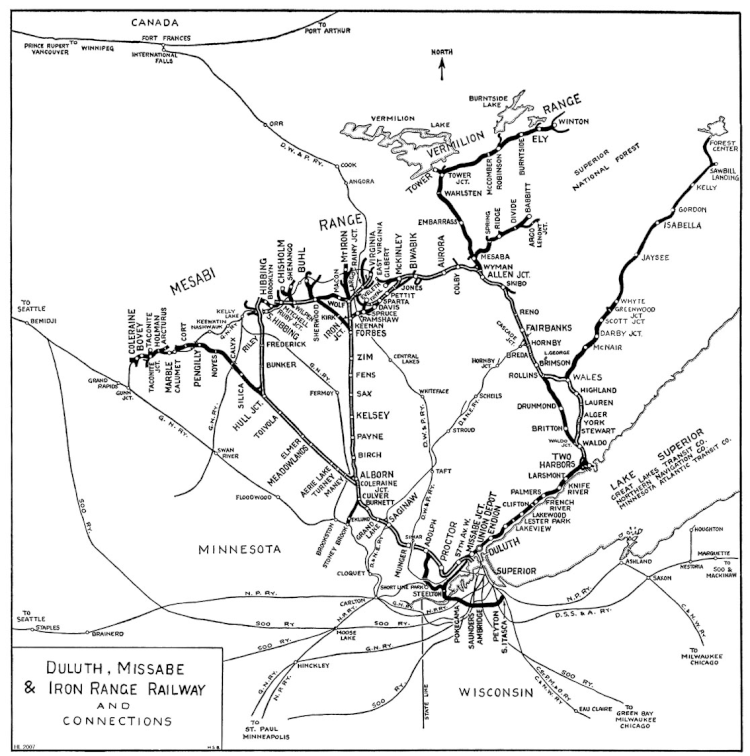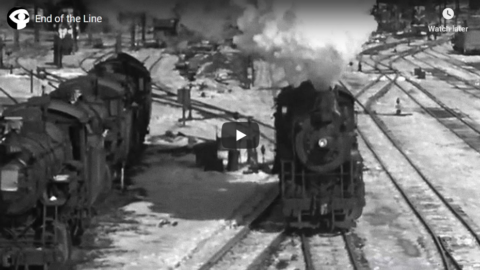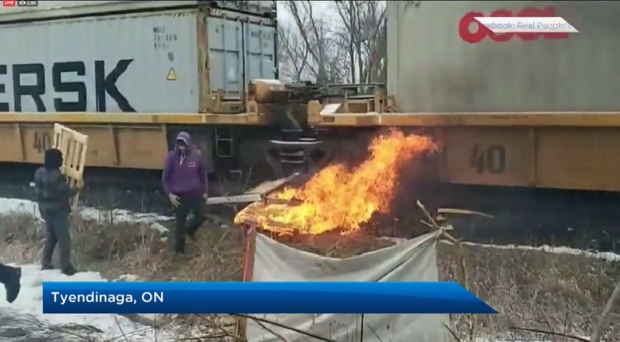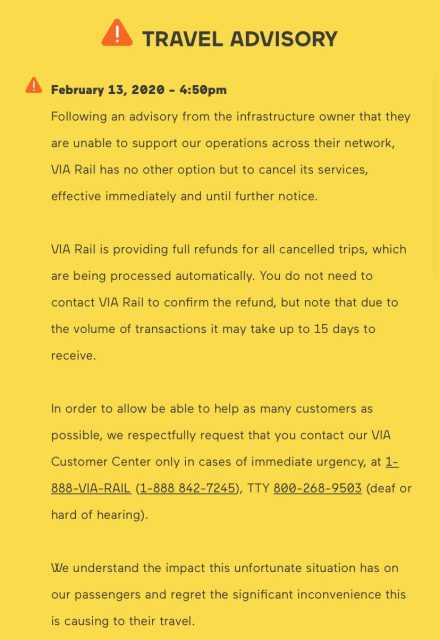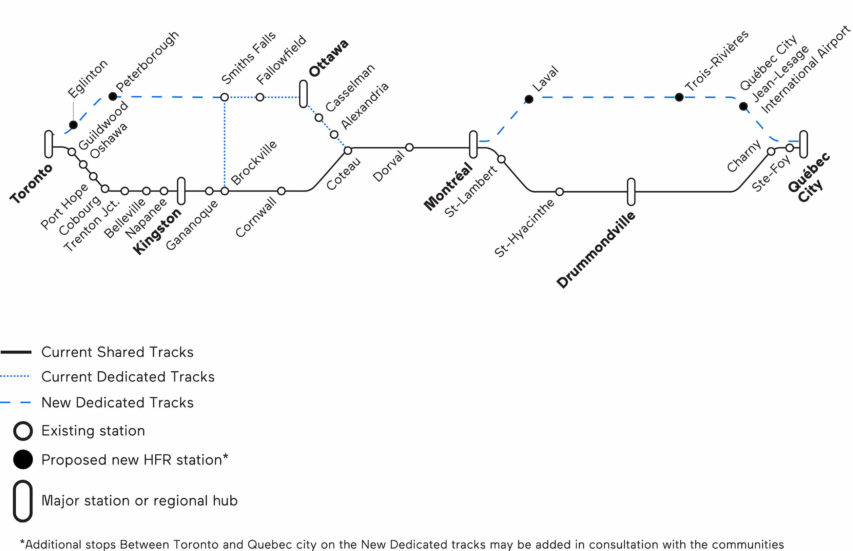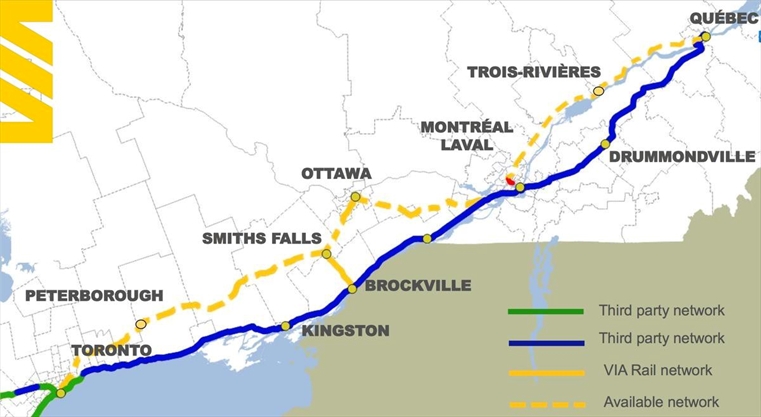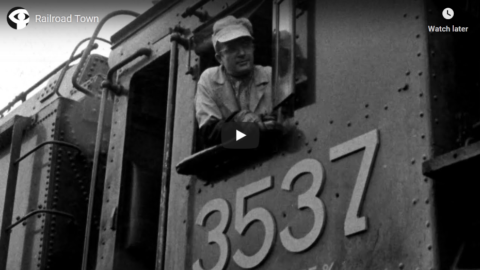NFB
Published 15 Jun 2015In this film Keaton rides across Canada on a railway scooter and, between times, rests in a specially appointed passenger coach where he and Mrs. Keaton lived during their Canadian film assignment. This film is about how Buster Keaton made a Canadian travel film, The Railrodder. In this informal study the comedian regales the film crew with anecdotes of a lifetime in show business. Excerpts from his silent slapstick films are shown
Directed by John Spotton – 1965.
July 4, 2023
Buster Keaton Rides Again (1965)
July 21, 2022
The Railrodder (1965)
NFB
Published 15 May 2015This short film from director Gerald Potterton (Heavy Metal) stars Buster Keaton in one of the last films of his long career. As “the railrodder”, Keaton crosses Canada from east to west on a railway track speeder. True to Keaton’s genre, the film is full of sight gags as our protagonist putt-putts his way to British Columbia. Not a word is spoken throughout, and Keaton is as spry and ingenious at fetching laughs as he was in the old days of the silent slapsticks.
Directed by Gerald Potterton – 1965
April 8, 2021
Fallen Flag — the Duluth, Missabe & Iron Range Railway

The Merritt family of Minnesota (known as the “Seven Iron Brothers“) discovered a large iron ore deposit in the Mesabi Range and created the largest iron ore mine in the world (as of the 1890s) and tried to persuade the DMN to build a 70-mile rail connection to get their ore to harbour and out to the iron and steel foundries around the Great Lakes. The DMN was unwilling to commit, so the Merritt family borrowed money to build the line from, among other financiers, John D. Rockefeller. The line — called the Duluth, Missabe and Northern — got built and began operations in 1892, but the Merritts expanded too quickly at the wrong moment — the financial panic of 1893 — losing financial control and leaving ownership of both the mine and the railway in Rockefeller’s hands by 1894.
Charlemagne Tower sold the Duluth & Iron Range to Illinois Steel in 1887, which was succeeded by Federal Steel, then U.S. Steel. By 1901, both the D&IR and DM&N were under U.S. Steel control. USS upgraded both railroads with heavy rail and double track, ordered bigger locomotives and larger cars, and built sizeable shops and roundhouses at Proctor and Two Harbors.
In 1915 DM&N leased the Spirit Lake Transfer Railway, a link between DM&N at Adolph, near Proctor, and the Interstate Transfer Railway at Oliver, Wis., across from Steelton, Minn. The Interstate Transfer ran from Oliver to Itasca, in eastern Superior, giving the DM&N connections with large railroads including Northern Pacific, Chicago & North Western’s “Omaha Road”, and three members of the Canadian Pacific family: Minneapolis, St. Paul & Sault Ste. Marie (“Soo Line”); Wisconsin Central; and Duluth, South Shore & Atlantic.
DM&N and D&IR remained separate until January 1, 1930, when the DM&N leased the D&IR and consolidated operations. Then on July 1, 1937, the DM&N merged with the Spirit Lake Transfer to form the Duluth, Missabe & Iron Range Railway. DM&IR then acquired ownership of D&IR and Interstate Transfer, and they became part of the new corporation on March 22, 1938. Reminders of the two big predecessors remained in the DM&IR’s two operating divisions, named Iron Range and Missabe, made up primarily of the predecessors’ tracks.
The Great Depression drastically reduced ore traffic. In 1932, not a single all-ore train was run — the small amount of ore that had to be shipped was carried in mixed freights. World War II reversed the road’s fortunes, of course, and the postwar boom resulted in an even higher demand for ore, with an all-time tonnage record being set in 1953.
Missabe had minimal passenger service. Into the 1950s, handsome Pacifics pulled heavyweight steel RPOs and coaches, two with solarium observation sections. At the end of World War II, the Missabe still provided service between Duluth and Ely (Winton), and Duluth and Hibbing, with the Hibbing train connecting with one from Iron Junction to Virginia.
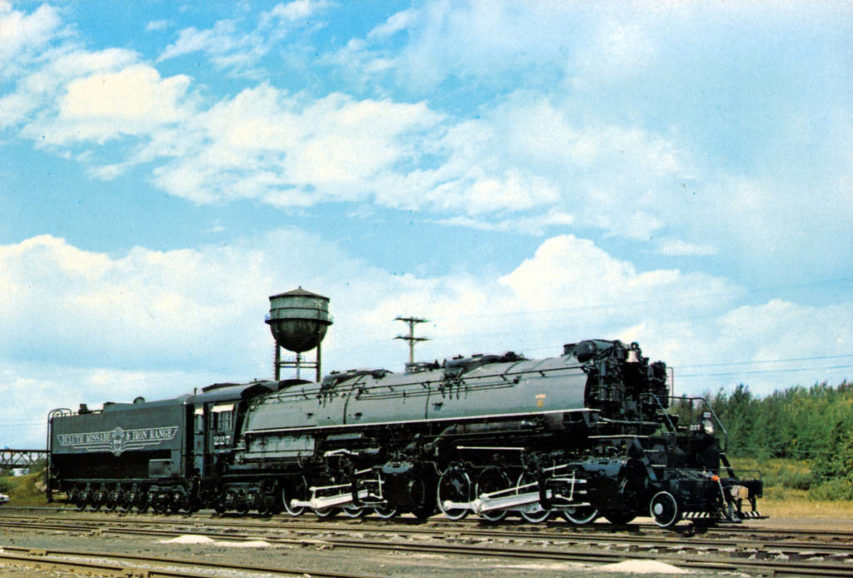
Duluth, Missabe & Iron Range M-3 locomotive no. 227.
Photo by “GavinTheGazelle” via Wikimedia Commons.
U.S. Steel spun off the DM&IR and its other ore railroads and shipping companies to subsidiary Transtar in 1988, selling majority control to the Blackstone Group. In 2001, DM&IR and other holdings were moved from Transtar to Great Lakes Transportation, fully owned by Blackstone, so for the first time in a century, DM&IR was no longer associated with U.S. Steel. On October 20, 2003, Canadian National announced it would buy Great Lakes Transportation, which also owned Bessemer & Lake Erie, Pittsburgh & Conneaut Dock Co. in Ohio, and Great Lakes Fleet, Inc. The purchase was finalized on May 10, 2004, and the independent Missabe Road vanished.
CN retired all but 10 of the SD40-3s, most of the SD38s, and all the rebuilt SD9s and 18s. Major locomotive work shifted from Proctor to other shops, and train dispatchers moved to Wisconsin, then Illinois. CN invested in new ore cars for the Missabe, gradually replacing those that dated to when steam still ruled the railroad. DM&IR existed on paper until December 31, 2011, when CN merged subsidiaries DM&IR and Duluth, Winnipeg & Pacific into Wisconsin Central.
June 29, 2020
The End of the Line
NFB
Published 2 Sep 2015This documentary short offers a nostalgic look at the steam locomotive as it passes from reality to history. In its heyday, the big smoke-belching steam engine seemed immortal. Now, powerful and efficient diesels are pushing the old coal-burning locomotives to the sidelines, and the lonely echo of their whistles may soon be a thing of the past.
Directed by Terence Macartney-Filgate – 1959.
May 23, 2020
“If you want to advance your cause, make friends with the Ontario Mohawks. They pretty much run the country.”
Chris Selley on the utter, abject defeat of the Canadian and British Columbian governments in their “negotiations” with the hereditary leadership of the Wet’suwet’en:

“Vancouver Solidarity with Wet’suwet’en” by jencastrotakespictures is licensed under CC BY-NC-SA 2.0
“We’re not understanding what is the rush here,” elected chief Maureen Luggi told CBC — a sentiment Naziel echoed. “We sat here for 30 years already, waiting and talking about it,” Naziel said. “We can wait another year or two. It’s not going to hurt anything.”
Indeed, from the average Wet’suwet’en member’s point of view, there is no hurry at all. The logical thing would be to fix the governance structure, heal the wounds that need healing, and then undertake these monumental negotiations.
But for the governments involved, this wasn’t about offering the Wet’suwet’en a better future. It was about putting out a fire: A group of Mohawks thousands of kilometres away in eastern Ontario had blockaded CN’s main line in solidarity with the hereditary chiefs; and the Ontario Provincial Police, armed with an injunction demanding the blockade end, refused to lift a finger.
Something had to give. Somebody had to get screwed, and it was the rank-and-file Wet’suwet’en. For no good reason whatsoever, the hereditary chiefs now hold all the keys to their future. It’s an appalling and appallingly predictable result.
“I don’t see why the government gave them this, because this has got nothing to do with what the protests across Canada started from,” chief Dan George of Ts’il Kaz Koh First Nation told CBC. “Those issues are not resolved. They can set up roadblocks again and do it again, and that’s what I’m worried about.”
If negotiations don’t go well, that might well prove to be a prescient remark. But for now, the hereditary chiefs’ victory is total: They have every reason to stay the course. The message to other groups, however, is clear: If you want to advance your cause, make friends with the Ontario Mohawks. They pretty much run the country.
March 11, 2020
Canadian National’s perfect storm
In Trains, Bill Stephens highlights the terrible time Canada’s largest railway has been having since the beginning of the year:
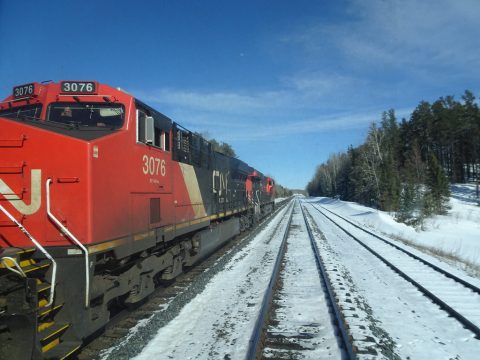
“DSC02285” by Bengt 1955 is licensed under CC BY-NC 2.0
It would be hard to imagine a worse start to the year for Canadian National, whose volume is down 16% due to a string of events that’s mostly odd, unrelated, and unrelenting. CN is taking it on the chin, as no other North American railroad has seen its volume fall by more than 10% this year and rival Canadian Pacific’s traffic is up 10%.
First, there was Mother Nature. Winter arrived in January with eight days of deep cold in Western Canada, forcing CN to restrict train length. Then powerful rainstorms lashed southern British Columbia starting Jan. 30, washing out CN’s main to Vancouver for six days.
The major washouts occurred in the rugged Fraser River canyon directional running zone where CN and CP share trackage, with CN hosting westbounds and CP carrying eastbounds. The railways had to resort to running directional fleets of 15 to 20 trains at a time over CP’s line. The single-track bottleneck caused eastbound traffic to stack up at the Port of Vancouver and westbounds to be staged as far away as the Prairies. The directional running zone ranks among the top three freight mains by tonnage in North America, alongside BNSF Railway’s Southern Transcon in the Southwest and Union Pacific’s triple track across Nebraska. So this blockage was, by itself, a big deal.
Then came nearly a month of civil protests. On Feb. 6, as CN began digging out from the washout backlog, the first of several First Nations blockades set up camp on CN’s tracks. The blockades, protesting a proposed natural gas pipeline in British Columbia, halted traffic on CN’s Montreal-Toronto mainline in the East. Also ultimately affected: CN’s line to Prince Rupert, British Columbia, which was blocked by protests for six days. Other protests came and went in Edmonton, Alberta; Winnipeg, Manitoba; Quebec; and British Columbia. CP was affected, too, but to a much lesser extent. CP even hosted detour traffic for CN between Montreal and Toronto.
As if that wasn’t enough, then came regulatory woes. The same day the protests began, a CP crude oil train derailed and caught fire in Guernsey, Sask., the second such wreck in the area since December. Hours later Transport Canada issued a ministerial order that restricted key trains – those with 20 or more cars of hazardous materials – to 20 mph in metropolitan areas and 25 mph elsewhere. With the stroke of a pen, Transport Minister Marc Garneau’s knee-jerk reaction effectively reduced CN’s overall capacity by a third. You could call this slowdown “Whoa Canada!”
February 16, 2020
The Canadian economy taken hostage while the PM swans around the world schmoozing for a temporary Security Council seat
Chris Selley on the state of play in the stand-off between (some) First Nations protesters and their temporary fellow travellers of the various permanent protest class:

“DSC02285” by Bengt 1955 is licensed under CC BY-NC 2.0
The majority of Wet’suwet’en First Nation members support the Coastal GasLink natural gas pipeline project, and they are in an objectively peculiar situation. On the one hand, the RCMP is doing its best to clear away the protesters and let construction proceed. On the other hand, anti-pipeline protesters claiming solidarity with the Wet’suwet’en have created chaos in their name — most notably the total shutdown of CN Rail’s eastern Canadian network, the cancellation of nearly every Canadian passenger train, and the layoffs and untold economic costs that go with that.
If protesters acknowledge the diversity of opinion among the Wet’suwet’en at all, they will defer to the authority of five hereditary chiefs who oppose the project, or observe that the five elected Wet’suwet’en band councils — all of which have signed community benefits agreements — represent a form of settler democracy imposed by the Indian Act.
[…]
Clearly the Wet’suwet’en are a divided community, including on the most basic questions of how they should be governed. It’s a mess. Mind you, look at the state of Canada as a whole.
Just as the RCMP have court authorization to clear protesters and encampments along the pipeline route, the Ontario Provincial Police have court authorization to clear the Mohawk rail blockade near Belleville, Ont. Unlike the RCMP, the OPP refuses to exercise its authority. And we just have to live with that. Conservative politicians are barking at Justin Trudeau to “enforce the law,” but he doesn’t give orders to the OPP, and neither does Ontario Premier Doug Ford, and nor should we want them to.
Still, you might expect senior ministers to have moderately stern words for folks illegally causing economic harm. You might expect the prime minister, at minimum, to be in the country. Instead, Trudeau spent the week swanning around Africa drumming up support for the UN Security Council seat with which he remains unaccountably obsessed, then decamped for the Munich Security Conference, where he was photographed warmly embracing Iranian foreign affairs minister Mohammad Javad Zarif, five weeks after Iran blew an airliner full of Canadians out of the sky over Tehran.
The Little Potato is probably doubly happy to have a valid (in his own mind) excuse for not being in the country at this particular time. He loves being the centre of attention … as long as that attention is friendly. He doesn’t handle situations well if the tempers are higher and the hostility is rising … like much of Canada right now.
The pipeline is a provincial project, not a federal one, but if the OPP won’t end the blockade and the feds aren’t willing to take truly extraordinary measures, then at some point in the foreseeable future it may well make short-term economic sense to give in to their demands. Maybe the feds can buy the pipeline from Coastal GasLink and shut it down.
And what if the Mohawks do lose interest, or are somehow induced to stand down? That now counts as the best-case scenario, and it will have involved shutting down the CN railway for at least a week — maybe two, maybe three — with enormous consequences for people’s livelihoods and the economy as a whole, all in the name of killing a project supported by the vast majority of Indigenous people affected by it. And it will happen again, as many times as any group wants it to, on whatever issue they want it to, for as long as they want it to. Unless someone in power does something unusually bold and concrete in the very near future – and it’s not even clear what that thing would be — we are well on the road as a country to being terminally screwed. In the meantime, we certainly have no lessons on accountable government to give the Wet’suwet’en.
February 15, 2020
Disrupting railways as an activist tactic appears to work really, really well
As Colby Cosh writes, for all the issues Alberta has with the government in Ottawa, nobody seriously suggested messing up the railways to get attention. Perhaps they should have:
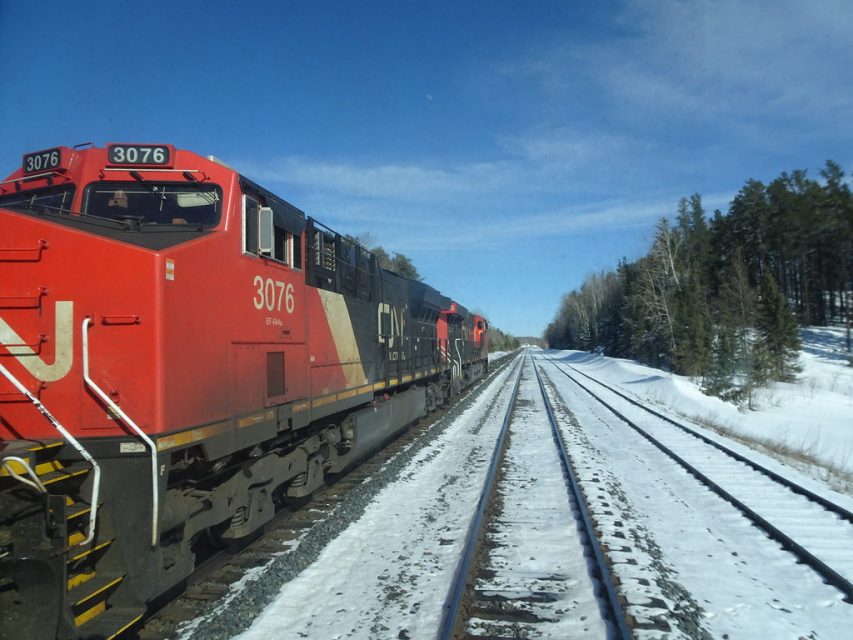
“DSC02285” by Bengt 1955 is licensed under CC BY-NC 2.0
It never occurred to us to mess with the rail network in Eastern Canada — to inconvenience the precious commuters of the Golden Horseshoe — as a means of gaining negotiating leverage. Actually, I’m sure some people must have suggested it, but they would have been written off as selfish, dangerous idiots advocating counterproductive tactics.
The economic impact of the rail protests is big, but surely comparable, at the moment, to that of a big storm. Yet because a B.C. Aboriginal community is carrying its fight with the B.C. government to the guts of Canada, the clamour over whether large public works are now possible at all in Canada has instantly achieved new and unfamiliar volume levels.
The Coastal GasLink that is the source of the strife is a provincially regulated work running from Dawson Creek to the coast; unlike the vastly more expensive problems Alberta has encountered, this technically isn’t an issue for the wider federation at all. Except, whoops, it is! Because someone decided to make it one!
The levels of irony dazzle the imagination. The Canadian West was settled by means of passenger rail, which is supposedly one reason it was chosen as a target by the radicals supporting the Wet’suwet’en hereditary chiefs in their pipeline fight. But intercity commuter rail no longer really exists between the West Coast and Hamilton. The West is ultimately as dependent on rail freight as the East, and maybe more so, but it was that commuter inconvenience that gave rise to an immediate sense of national crisis, while Calgary and Saskatoon and Winnipeg snoozed.
And climate-change activists found themselves blocking rail lines in “solidarity” with the Wet’suwet’en, even though the chiefs’ fight is a question of territorial principle rather than carbon sins. This put the greenies in the position of opposing and thwarting actual rail travel. They admit this is anomalous; nobody likes to attach the word “hypocritical” to himself.
One of the protesters pointed out to the Star‘s Alex Boyd how dependence on rail — dependence of the sort that they spend 364 days a year advocating for intra-city commuters — facilitates unlawful, obstructive protest as a means for the self-anointed to “put pressure on decision-makers.” It is a little harder to block paved roads than railroads, and much harder to sabotage them, if it comes to that — which it might have if the police had used force to immediately disperse the protests. For some, this counts as a feature of rail, not a bug.
February 14, 2020
The reaction to the Mohawk blockade near Belleville shows that VIA Rail isn’t a serious company
Mohawk protesters began blocking the main CN and VIA line between Toronto and Montreal near Belleville nearly a week ago. The police, having learned so often that the government and the courts won’t back them up, did little to try to get the blockade lifted other than to prevent active confrontations with the First Nations activists. Canadian National announced that they were being forced to park trains all over Eastern Canada as a result of the blockade and that deliveries of goods would be snarled for quite some time even after service is allowed to resume. VIA rail, on the other hand, seems to care not a bit about the thousands of travellers who have been stranded mid-journey and made no apparent efforts to bring in buses or any other arrangements. Chris Selley says this proves that VIA is not an essential service even in their own minds:
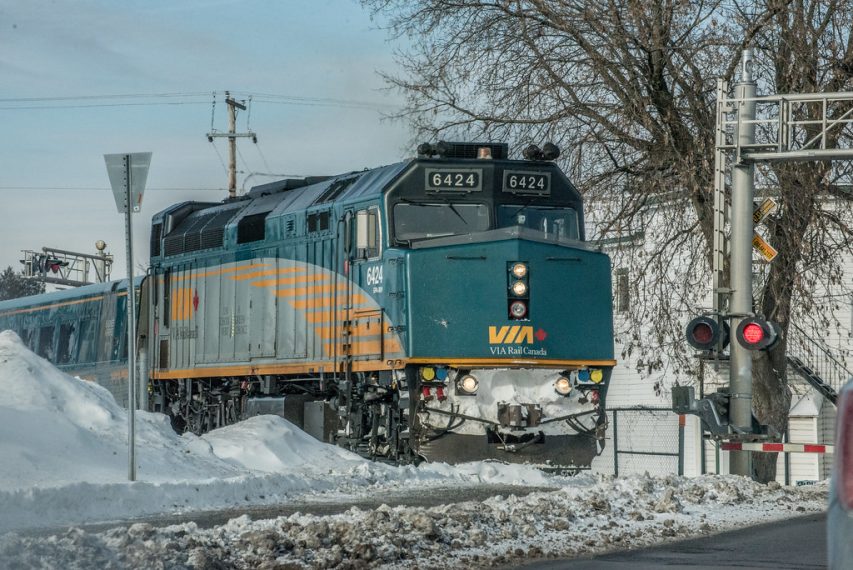
“The 6424” by Stephen Downes is licensed under CC BY-NC-SA 2.0
Of all the bad news to befall VIA Rail this week, with the cancellation of all its trains between Toronto and Ottawa and Toronto and Montreal — that’s roughly 50 per cent of its ridership and 60 per cent of its revenues — the worst news might be just how little news it has made. Mostly, the Mohawk blockade of the CN main line near Belleville, Ont., has been treated as a side story to the anti-pipeline protests and arrests in the British Columbia interior.
That’s what it is in the grand scheme of things: The battle between Wet’suwet’en members and chiefs and the federal government speaks to much larger, existential questions about the future of the Canadian economy, about the Liberal government’s reconciliation agenda, about the very nature of the Canadian federation and the rule of law. This blockade, launched in the name of solidarity with the Wet’suwet’en, just means people have to take the bus, or fly, instead of the train.
But that’s no small inconvenience, no small expense. Canadians in general are not quick to anger, but very few of the VIA refugees interviewed by various news outlets sounded even slightly furious, which they had every right to be. When protesters from the same First Nation blockaded the same set of tracks six years ago, VIA properly exhibited some concern with getting their customers to their destinations and put on replacement buses.
This time around, no buses. No suggestions. No response to media inquiries asking why there are no buses. Just a cancellation notice on the website and a fare-thee-well. At a time when VIA is seeking untold billions from the federal government to build a new Toronto-Ottawa-Montreal route and run vastly more trains, this does not bespeak a company that takes itself very seriously.
[…]
And never mind VIA, what sort of country lets a few people close down a key piece of national infrastructure, in violation of a court injunction — not for an hour or a day, but literally indefinitely? For a time it wasn’t even clear whose job it was to enforce the injunction: On Sunday an Ontario Provincial Police spokesperson told Global News it was up to the CN Police Service. On Tuesday, a CN spokesperson told the National Post it was up to the OPP, and indeed, late Tuesday OPP officers warned protesters to leave or they would be forced out. Perhaps the threat of massive economic disruption finally lit a fire under them: earlier in the day, CN had said it was considering shutting down huge parts of its freight network across the country. Had it just been rail passengers, though, the idea of this side-protest dragging on for weeks or even months seems absurdly plausible.
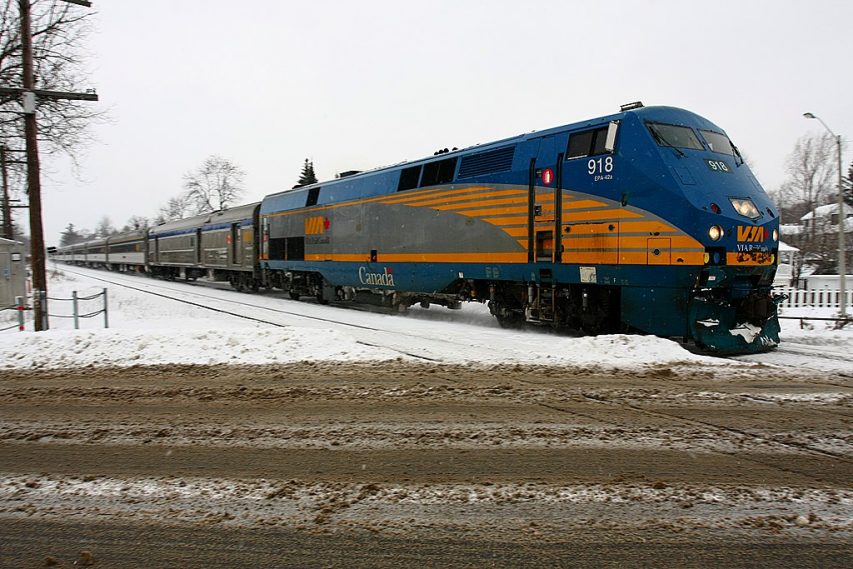
VIA Rail 918, a General Electric model P42DC locomotive, at Belleville, Ontario on 23 December 2008.
Photo by Martin Cathrae via Wikimedia Commons.
While VIA may not be serious, others are extremely serious:
Left-wing blogs have been offering instructions and maps during the #ShutDownCanada protests on how to blockade and destroy train tracks and other pieces of Canada’s infrastructure, according to True North.
Two websites in particular, these being North Shore and Warrior Up, have instructed demonstrators how to damage Canada’s pipelines, roads and railways.
In some of North Shore’s posts, for instance, they told their readers to stand in solidarity with the Wet’suwet’en tribe by destroying train tracks. In this article, the author makes it perfectly clear that he wants to damage Canada’s economy at large.
More absurdly, however, the article then went on to instruct the reader on how to compose a chemical mixture that destroys steel rail tracks — taking particular care to describe how not to leaving fingerprint or DNA evidence.
Thursday evening, VIA Rail announced their whole passenger network would be shut down until further notice: Service cancellation notice.
July 17, 2019
VIA Rail’s “High Frequency Rail” proposal
In Trains, Bill Stephens outlines some of the strikes against VIA Rail Canada’s hopes for a dedicated passenger-train-only route between Toronto and Quebec City:
Last month VIA’s $4 billion plan got a $71 million boost that will fund additional feasibility studies. It shouldn’t take $71 million to figure out the plan is fatally flawed. Why? Because it won’t accomplish its chief aim: Eliminating the mind-boggling delays related to sharing tracks with Canadian National freight trains.
To be successful, passenger service needs to be fast, frequent, and dependable. VIA’s current service is faster than driving between Canada’s two biggest cities, Toronto and Montreal. It’s fairly frequent, too, with seven weekday departures between Toronto and Montreal. But it’s not dependable. On-time performance is in the low 70% range for the entire Toronto-Ottawa-Montreal-Quebec City corridor. VIA blames the late trains on interference from CN freights, primarily on the double-track route linking Toronto and Montreal.
So you can understand why VIA would lobby the Canadian government for a dedicated passenger route. Last year VIA’s Eastern Corridor, the Canadian equivalent of Amtrak’s Northeast Corridor, carried three-quarters of VIA’s entire ridership. It stands to reason that you can fill more seats with service that’s faster, more frequent, and more reliable.
[…]
Keeping passenger and freight trains on time takes a combination of operational discipline, the right track capacity, and a willingness to make it work. CN takes pride in its operational discipline, and executives say the Eastern portion of the railroad, between Chicago and Halifax, is underutilized. What’s missing, it seems, is a willingness to expedite VIA trains.
VIA needs a cooperative host railroad more than it needs a new route that would bypass intermediate population centers, face opposition from the not-in-my-backyard crowd, take years to build, and in the end would still have to rely on shared trackage in key areas.
Also a monumental problem without an apparent solution: Squeezing extra trains into Toronto Union Station and Central Station in Montreal on new approaches that would only complicate operations and increase conflicts with freight and commuter traffic.
June 4, 2019
Railroad Town
NFB
Published on 7 Aug 2017This short documentary is a delightful trip back to an era in which railroad was king.
Directed by Don Haldane
About the NFB
The National Film Board of Canada produces and distributes documentary films, animation, web documentaries and fiction. Our stories explore the world we live in from a Canadian point of view.Watch over 3,000 films for free on NFB.ca – http://bit.ly/YThpNFB
Want more? Sign up for our newsletter – http://bit.ly/YTnwNFBConnect with the NFB online:
Twitter: http://bit.ly/yttwNFB
May 20, 2017
On board The Canadian
The Toronto Star‘s Jennifer Bain takes a trip on VIA Rail’s premier passenger train from Toronto to Vancouver:
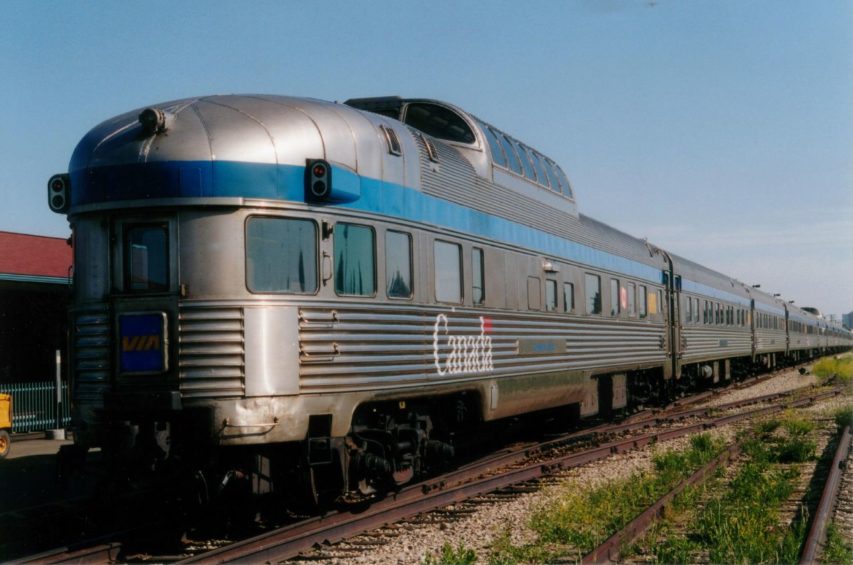
VIA dome observation car, 2007. Photo by Savannah Grandfather (Wikimedia)
ABOARD THE CANADIAN-That first overnight on the train was a gloriously sleepless blur disrupted by clickety clacks, rumbles, grinding squeals and ding, ding dings. Alone in F-130 in the Château Cadillac car on a Murphy bed pulled down from the wall to fill the room, I stared mesmerized through an extra-large window into the dark depths of northern Ontario and thought deeply Canadian thoughts.
Happy 150th birthday, Canada. This year cries out for a celebratory road trip. I use the term road loosely. A train track will do just fine. Let someone else drive. For four nights on the Canadian, Via Rail Canada’s iconic train from Toronto to Vancouver, I relaxed and watched boreal forest become prairie and then mountains.
Somewhere north of Sudbury that first morning, I threw on clothes and tiptoed down the narrow hall, hands outstretched to brace for sways and lurches, through the Château Dollard sleeping car to the end of the train.
The Laurentide Park car is tricked out with a downstairs lounge and upstairs domed seating area. The DIY tea and coffee station became my watering hole.
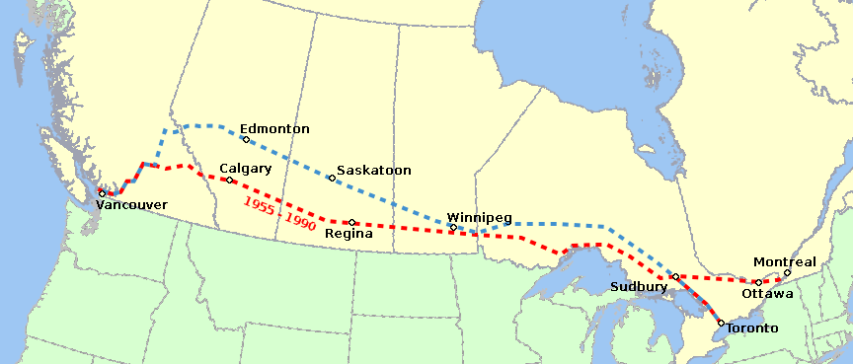
Routes of The Canadian: the original 1955 route is in red (on CPR trackage) and the current route is in blue (mainly on CN tracks). VIA took over operation of The Canadian in 1978 and changed to the current route in 1990.
You are in your own world on the Canadian, but not necessarily alone. Work on the lost art of small talk in the dining car when you’re seated with strangers. Play a board game with fellow passengers since there’s no Wi-Fi and often no cell service.
This 4,466-kilometre journey is a throwback to simpler times.
Jason Shron — a train nut from Thornhill that I met through Box — has done the Canadian upwards of 40 times and found “there’s a tendency for people on the train to spill their guts to strangers,” especially if they’re on divorce tours, which can become awkward the next day. “There’s a certain magic to that,” he admitted. He was taking his three kids to Winnipeg to meet his wife and other family for Passover.
Shron owns Canada’s largest model train company, built a section of a full-size Via car in his basement, is restoring two train cars and is writing a book about Via for its 40th anniversary next year. The Crown corporation “doesn’t celebrate its own history and doesn’t celebrate its own people” nearly enough, he lamented, and so he’s “like this one-man Via fan club.”
Make that two. Shron and Box love trains for different reasons — the actual machines and the art of train travel — but they are anomalies. Too many Canadians have never been on a train, much less slept on one.
Trains are not a part of our modern lives or lexicon, so my learning curve is steep. Passenger trains don’t have cabooses, conductors are obsolete and drivers are called engineers. Freight trains have priority in Canada when there’s one line, so passenger trains like the Canadian have to wait on the siding, causing delays.
There are economy-class seats that you sleep upright in, and banks of seats that convert into upper and lower “berths” at night with just a curtain for privacy. There are private rooms, some with a toilet that gets covered when the bed comes out, and a shared shower down the hall. I was lucky enough to experience “Prestige class” in a room with an L-shaped couch, Murphy bed and private en-suite washroom, with access to a trio of concierges, reserved seating at the front of the dome car, meals, booze and all the Earl Grey I could drink.
Part of the reason “many Canadians have never been on a train” is that there are a lot fewer trains running today than in years past: when VIA took over most intercity passenger service, it rationalized a lot of the routes (but not enough to become profitable, hence the federal government’s ongoing subsidies to VIA). Even with those subsidies, passenger trains aren’t a bargain for the average traveller, and usually compare poorly to bus or air travel in both cost and frequency. Most of VIA’s trains lose money, as this table from 2014 shows:
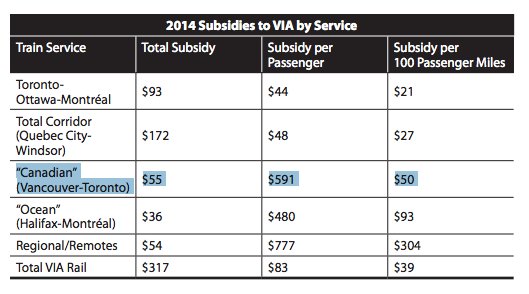
So, how expensive is the trip that Ms. Bain took? I went to the VIA website to find out. Booking a trip from Toronto (in my case, Oshawa) to Vancouver on The Canadian to leave today (Saturday) would cost an eye-watering $9,684.10 per person in Prestige class (including a $500 service fee, but not including HST [Harmonized Sales Tax] of $1,114.10). There are cheaper fares — booking in advance, not taking the Prestige class ticket, other available sales, etc. — but a quick Google search shows return flights in the $600 range (but I could save $226 off that if I booked for tomorrow instead of today).
For a potted history of The Canadian there’s a useful Wikipedia page.
December 13, 2016
“Canadian National was using Metrolinx as an automated teller machine”
The two big Canadian railway corporations have taken full advantage of the weak internal financial controls at Metrolinx:
For much of the past two decades Canadian National Railway Co. has been credited with revolutionizing the North American railroad industry.
The company’s former chief executive E. Hunter Harrison’s theory of “precision railroading” — a data-driven focus on charging customers a premium for superior on-time performance — made him an industry icon and his shareholders very happy.
But in railroading, as in life, how you get there matters.
Acting on a tip, the Southern Investigative Reporting Foundation began investigating Canadian National in the fall of 2014. Here’s what our reporting uncovered:
- For over 15 years Canadian National earned hundreds of millions of dollars in profit by marking up rail construction costs up more than 900 percent to a public-sector client.
- Canadian National regularly engaged in questionable business practices like charging internal capital maintenance and expansion projects to the same taxpayer-funded client and billing millions of dollars for work that was never done.
- A just-released auditor general investigation suggested a series of reforms that will reduce these profits.
- For years, train yard personnel, under intense pressure from management, have intentionally misreported on-time performance, helping it boost revenues by hundreds of millions of dollars.
[…]
Long before the Ontario auditor general’s office began its investigation, Canadian National was using Metrolinx as an automated teller machine, albeit one with no deposits required. Over 15 years executive teams have come and gone at Canadian National but the one constant has been the river of profit that its Toronto construction unit has been able to reliably wring from Metrolinx.
Determining how much Canadian National has billed Metrolinx over the past two decades is difficult but since 2010, adding up four separate land sales, the Lakeshore West construction discussed below and ongoing maintenance contracts it’s at least $1.1 billion, the majority of which likely went straight to operating income. In other words, Metrolinx’s long-running failure to properly scrutinize Canadian National emboldened it to charge prices so high that many of the construction and maintenance contracts amounted to almost pure profit.
The most audacious episode occurred from 2004 to 2008 when Canadian National’s construction managers developed a billing scheme that reaped hundreds of millions of dollars in profits and benefits by wildly inflating the cost of construction, according to documents obtained by the Southern Investigative Reporting Foundation and attached to ongoing litigation.
The project involved a track expansion project that Canadian National performed for Metrolinx’s Lakeshore West line, on a route that stretched about 40 miles from Hamilton, Ontario, to Toronto’s Union Station. The work was completed in 2012.
Windfall profits and bonus payouts weren’t the half of it. In numerous instances Canadian National billed Metrolinx for work that Canadian National did for its own capital maintenance and expansion projects, saving itself many millions of dollars in expenses.
From 2004 to 2008, Canadian National did track construction work for Metrolinx on a 4.5-mile stretch between the Burlington and Hamilton stations, referred to by Canadian National as Lakeshore West/West. On a separate stretch of the same track in late 2009, crews began adding track to the 9.1-mile stretch from the Port Credit station to Kerr Street, or the Lakeshore West/East line. (The Ontario auditor general’s annual report discussed an unnamed 9-mile track extension that cost $95 million to construct “on the Lakeshore West corridor” but did not identify the project’s location or its date of completion.)
The Lakeshore West/West project’s cost is unclear.
Based on this email, Metrolinx had originally approved a construction price tag of $45 million, but in short order the project’s chief engineer Daryl Barnett, in a bid to reduce costs, noted the price tag had quickly ballooned past $70 million. Metrolinx’s spokeswoman Aikins did not answer repeated questions on the matter but the Southern Investigative Reporting Foundation obtained an April 2015 internal audit Metrolinx conducted at the auditor general’s request that put the final tab for Canadian National’s 2004 to 2008 work on that stretch at “over $200 million.”
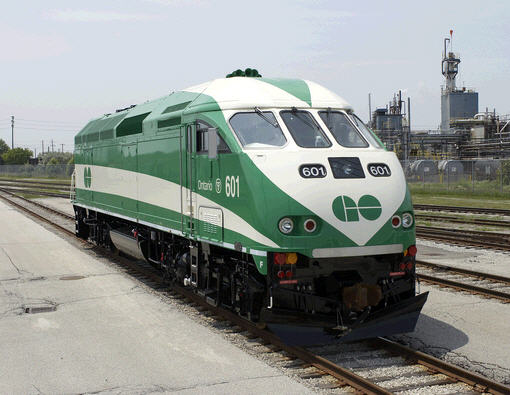
GO Transit operates bus and rail service in the Greater Toronto Area as part of Metrolinx
September 29, 2012
CN experiments with natural gas for its locomotives
Canadian National Railways is running a limited experiment with a pair of retro-fitted diesel locomotives converted to running on natural gas:
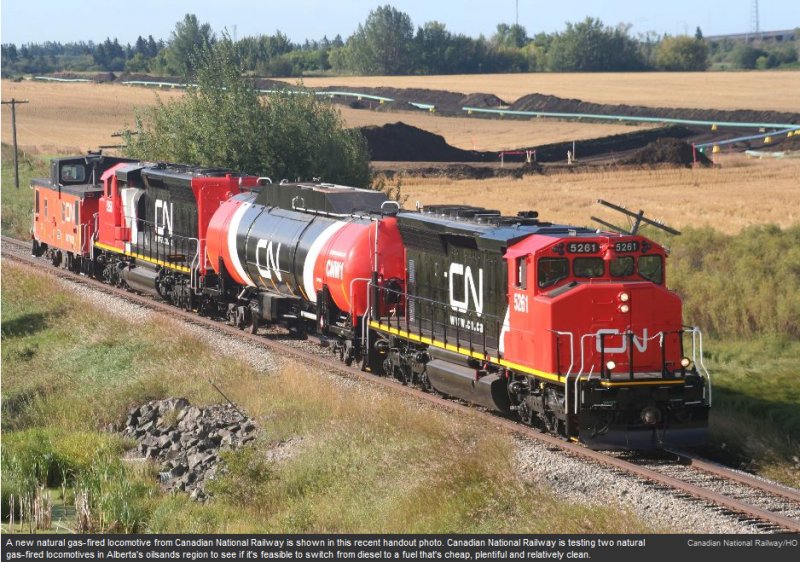
Canadian National Railway is exploring whether its feasible to use cheap and relatively clean natural gas to power its trains instead of diesel.
CN has retrofitted two of its existing diesel-fired locomotives to run mainly on natural gas. It’s testing the locomotives along the 480-kilometre stretch between Edmonton, a key energy processing and pipeline hub, and the oilsands epicentre of Fort McMurray, Alta.
Longer term, CN and three other partners are looking at developing an all-new natural gas locomotive engine as well as a specialized tank car to carry the fuel.
February 26, 2011
The increasing length of freight trains in Canada
Some eye-opening statistics on the length of freight trains being run by Canadian National (CN) and Canadian Pacific (CP) these days:
Transport Canada launched a six-part study into the long-train strategies at the country’s largest railways this month with an eye on developing policies for how these longer, heavier trains are assembled and run. The goal of the two-year study is to develop science-based regulations that will hopefully reduce the number of derailments in the country.
Despite the concern from regulators, these longer, heavier trains in recent years have been a godsend for North American railways, which swear by their safety. Not only do they improve the efficiency of the rails by reducing the number of trains required to transport goods, but they in turn reduce the crews needed and the fuel used to move their shipments.
If properly built, they can also reduce wear and tear on the trains and the tracks themselves by cutting down on in-train forces, lowering maintenance costs substantially over time.
The cynic in my asks why, if CN (for example) actually managed to reduce the number of rail accidents to an all-time low last year, the regulators are now launching the investigation. Fewer accidents now equals a point of serious concern on the part of the regulators? Why?
Up until the 1990s, the average freight train in Canada was about 5,000 feet (1.54 kilometres) long and weighed 7,000 tons. But it is now not uncommon to see these trains stretch to 12,000 feet, sometimes as much as 14,000 feet (more than four kilometres), weighing up to 18,000 tons.
While CN is comfortable sticking with the size of its longest trains now, about 12,000 feet, CP continues to push the boundaries of how long it can build its trains by developing some of the industry’s most cutting-edge technology in recent years to help it do so.
The benefits are clear. CP estimates, for example, that the labour costs alone on a typical transcontinental train are now 30% lower than they would be if it was using smaller trains.
So, the trains are longer, carry far more freight, cost less to run, and customers are happy. The government must act!

